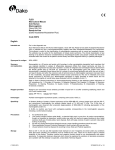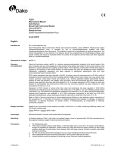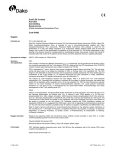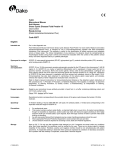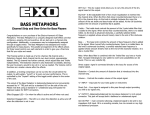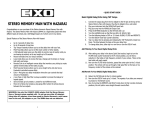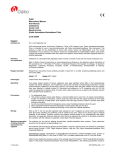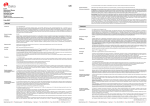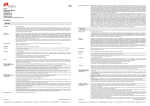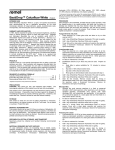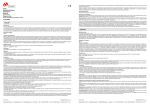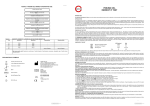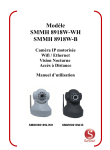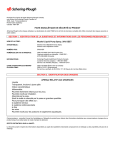Download Monoclonal Mouse
Transcript
FLEX Monoclonal Mouse Anti-Human Smooth Muscle Myosin Heavy Chain Clone SMMS-1 Ready-to-Use (Dako Autostainer/Autostainer Plus) Code IS066 Intended use For in vitro diagnostic use. FLEX Monoclonal Mouse Anti-Human Smooth Muscle Myosin Heavy Chain, Clone SMMS-1, Ready-to-Use (Dako Autostainer/Autostainer Plus), is intended for use in immunohistochemistry together with Dako Autostainer/Autostainer Plus instruments. This antibody is useful for the identification of breast myoepithelial cells. Myoepithelial cells are generally present in breast hyperplasia and ductal carcinoma in situ, and absent in invasive breast carcinoma (1-5). The clinical interpretation of any staining or its absence should be complemented by morphological studies using proper controls and should be evaluated within the context of the patient's clinical history and other diagnostic tests by a qualified pathologist. Summary and explanation Smooth muscle myosin heavy chain (SM-MHC) is a cytoplasmic structural protein which is a major component of the contractile apparatus in smooth muscle cells. Expression of smooth muscle myosin is developmentally regulated, appearing early in smooth muscle development, and is specific for smooth muscle development (1,2). Two isoforms of smooth muscle myosin heavy chain have been identified, designated MHC-1 and MHC-2 (3,4). Refer to Dako’s General Instructions for Immunohistochemical Staining or the detection system instructions of IHC procedures for: 1) Principle of Procedure, 2) Materials Required, Not Supplied, 3) Storage, 4) Specimen Preparation, 5) Staining Procedure, 6) Quality Control, 7) Troubleshooting, 8) Interpretation of Staining, 9) General Limitations. Reagent provided Ready-to-use monoclonal mouse antibody provided in liquid form in a buffer containing stabilizing protein and 0.015 mol/L sodium azide. Clone: SMMS-1 (1). Isotype: IgG1, kappa. Immunogen Crude human uterus extract (1). Specificity In Western blotting of human aortic media extracts, the antibody reacts with both MHC-1 (205 kDa) and MHC-2 (200 kDa) isoforms (1). Precautions 1. 2. 3. 4. 5. For professional users. This product contains sodium azide (NaN3), a chemical highly toxic in pure form. At product concentrations, though not classified as hazardous, sodium azide may react with lead and copper plumbing to form highly explosive build-ups of metal azides. Upon disposal, flush with large volumes of water to prevent metal azide build-up in plumbing. As with any product derived from biological sources, proper handling procedures should be used. Wear appropriate Personal Protective Equipment to avoid contact with eyes and skin. Unused solution should be disposed of according to local, State and Federal regulations. Storage Store at 2-8 °C. Do not use after expiration date stamped on vial. If reagents are stored under any conditions other than those specified, the conditions must be verified by the user. There are no obvious signs to indicate instability of this product. Therefore, positive and negative controls should be run simultaneously with patient specimens. If unexpected staining is observed which cannot be explained by variations in laboratory procedures and a problem with the antibody is suspected, contact Dako Technical Support. Specimen preparation including materials required but not supplied The antibody can be used for labeling formalin-fixed, paraffin-embedded tissue sections. Tissue specimens should be cut into sections of approximately 4 µm. Pre-treatment with heat-induced epitope retrieval (HIER) is required. Optimal results are obtained by pretreating tissues using EnVision FLEX Target Retrieval Solution 3-in-1, High pH (10x), (Dako Autostainer/Autostainer Plus) (Code K8010/K8014). Deparaffinized sections: Pre-treatment of deparaffinized formalin-fixed, paraffin-embedded tissue sections is recommended using Dako PT Link (Code PT100/PT101). For details, please refer to the PT Link User Guide. Follow the pre-treatment procedure outlined in the package insert for EnVision FLEX Target Retrieval Solution, High pH (10x), (Dako Autostainer/Autostainer Plus) (Code K8010/K8014). The following parameters should be used for PT Link: Pre-heat temperature: 65 °C; epitope retrieval temperature and time: 97 °C for 20 (±1) minutes; cool down to 65 °C. Remove Autostainer slide rack with slides from the PT Link tank and immediately dip slides into a jar/tank (e.g., PT Link Rinse Station, Code PT109) containing diluted room temperature EnVision FLEX Wash Buffer (10x), (Dako Autostainer/Autostainer Plus) (Code K8010). Leave slides in Wash Buffer for 1-5 minutes. (118550-001) 307693EFG_001 p. 1/6 Paraffin-embedded sections: As alternative specimen preparation, both deparaffinization and epitope retrieval can be performed in the PT Link using a modified procedure. See the PT Link User Guide for instructions. After the staining procedure has been completed, the sections must be dehydrated, cleared and mounted using permanent mounting medium. The tissue sections should not dry out during the treatment or during the following immunohistochemical staining procedure. For greater adherence of tissue sections to glass slides, the use of Dako Silanized Slides (Code S3003) is recommended. Staining procedure including materials required but not supplied The recommended visualization system is EnVision FLEX, High pH, (Dako Autostainer/Autostainer Plus) (Code K8010). The staining steps and incubation times are pre-programmed into the software of Dako Autostainer/Autostainer Plus instruments, using the following protocols: Template protocol: FLEXRTU2 (200 µL dispense volume) or FLEXRTU3 (300 µL dispense volume) Autoprogram: SMM (without counterstaining) or SMMH (with counterstaining) The Auxiliary step should be set to “rinse buffer” in staining runs with ≤10 slides. For staining runs with >10 slides the Auxiliary step should be set to “none”. This ascertains comparable wash times. All incubation steps should be performed at room temperature. For details, please refer to the Operator’s Manual for the dedicated instrument. If the protocols are not available on the used Dako Autostainer instrument, please contact Dako Technical Services. Optimal conditions may vary depending on specimen and preparation methods, and should be determined by each individual laboratory. If the evaluating pathologist should desire a different staining intensity, a Dako Application Specialist/Technical Service Specialist can be contacted for information on re-programming of the protocol. Verify that the performance of the adjusted protocol is still valid by evaluating that the staining pattern is identical to the staining pattern described in “Performance characteristics”. Counterstaining in hematoxylin is recommended using EnVision FLEX Hematoxylin, (Dako Autostainer/Autostainer Plus) (Code K8018). Non-aqueous, permanent mounting medium is recommended. Positive and negative controls should be run simultaneously using the same protocol as the patient specimens. The positive control tissue should include uterus and appendix and the cells/structures should display reaction patterns as described for this tissue in “Performance characteristics” in all positive specimens. The recommended negative control reagent is FLEX Negative Control, Mouse, (Dako Autostainer/Autostainer Plus) (Code IS750). Staining interpretation The cellular staining pattern is cytoplasmic. Performance characteristics Normal tissues: In the adult aorta, cells of the tunica media and a majority of the smooth muscle cells in the subendothelial intima are labeled (1). In both uterus and appendix, the smooth muscle of wall and vessels exhibit cytoplasmic staining. Myoepithelial cells in ducts and acini of routinely processed normal breast also demonstrates positivity with the antibody (6). Periacinar and periductal myoepithelial cells of routinely fixed salivary gland stain positively with the antibody, whereas ductal cells were found to be unreactive (7). Abnormal tissues: The antibody has been shown to label the intact myoepithelial cell layers present in benign and in situ malignant breast lesions. Myoepithelial cell layers in benign neoplasms such as complex sclerosing lesions and papillomas have been shown to stain positively, whereas no myoepithelial immunostaining was observed in intracystic papillary carcinomas. Myosin expression was demonstrated in myoepithelial cells at the periphery of involved ducts and acini in ductal carcinoma in situ. Myoepithelial cells were not present in invasive breast carcinoma and labeling was restricted to stromal cells which stained only in a small proportion of the tumors tested (5). The antibody was also reported to label neoplastic myoepithelium of pleomorphic adenomas of the salivary gland (7). Français Réf. IS066 Utilisation prévue Pour utilisation diagnostique in vitro. L’anticorps FLEX Monoclonal Mouse Anti-Human Smooth Muscle Myosin Heavy Chain, Clone SMMS-1, Readyto-Use (Dako Autostainer/Autostainer Plus), est destiné à être utilisé en immunohistochimie avec les appareils Dako Autostainer/Autostainer Plus. Cet anticorps est utile pour l’identification des cellules myoépithéliales mammaires. Des cellules myoépithéliales sont en général présentes dans l'hyperplasie du sein et le carcinome canalaire in situ, mais absentes dans le carcinome invasif du sein (1-5). L’interprétation clinique de toute coloration ou son absence doit être complétée par des études morphologiques en utilisant des contrôles appropriés et doit être évaluée en fonction des antécédents cliniques du patient et d’autres tests diagnostiques par un pathologiste qualifié. Résumé et explication La chaîne lourde de la myosine du muscle lisse (SM-MHC pour Smooth Muscle Myosin Heavy Chain) est une protéine structurale cytoplasmique qui est un composant principal de l’appareil contractile dans les cellules du muscle lisse. L’expression de la myosine du muscle lisse est régulée d’un point de vue développemental, apparaissant précocement lors du développement du muscle lisse, et elle est spécifique au développement du muscle lisse (1,2). Deux isoformes de la chaîne lourde de la myosine du muscle lisse ont été identifiées, désignées MHC-1 et MHC-2 (3,4). Se reporter aux « Instructions générales de coloration immunohistochimique » de Dako ou aux instructions du système de détection relatives aux procédures IHC pour plus d’informations concernant les points suivants : 1) Principe de procédure, 2) Matériels requis mais non fournis, 3) Conservation, 4) Préparation des échantillons, 5) Procédure de coloration, 6) Contrôle qualité, 7) Dépannage, 8) Interprétation de la coloration, 9) Limites générales. (118550-001) 307693EFG_001 p. 2/6 Réactifs fournis Anticorps monoclonal de souris prêt à l’emploi fourni sous forme liquide dans un tampon contenant une protéine stabilisante et 0,015 mol/L d’azide de sodium. Clone : SMMS-1 (1). Isotype : IgG1, kappa. Immunogène Extrait brut d’utérus humain (1). Spécificité Lors de Western Blots effectués sur des extraits de média aortique humaine, l’anticorps présente une réaction avec les deux isoformes MHC-1 (205 kDa) et MHC-2 (200 kDa) (1). Précautions 1. 2. 3. 4. 5. Pour utilisateurs professionnels. Ce produit contient de l’azide de sodium (NaN3), un produit chimique hautement toxique sous sa forme pure. Aux concentrations du produit, bien que non classé comme dangereux, l’azide de sodium peut réagir avec le cuivre et le plomb des canalisations et former des accumulations d’azides métalliques hautement explosifs. Lors de l’élimination, rincer abondamment à l’eau pour éviter toute accumulation d’azide métallique dans les canalisations. Comme avec tout produit d’origine biologique, des procédures de manipulation appropriées doivent être respectées. Porter un vêtement de protection approprié pour éviter le contact avec les yeux et la peau. Les solutions non utilisées doivent être éliminées conformément aux réglementations locales et nationales. Conservation Conserver entre 2 et 8 °C. Ne pas utiliser après la date limite de péremption indiquée sur le flacon. Si les réactifs sont conservés dans des conditions autres que celles indiquées, celles-ci doivent être validées par l’utilisateur. Il n’y a aucun signe évident indiquant l’instabilité de ce produit. Par conséquent, des contrôles positifs et négatifs doivent être testés en même temps que les échantillons de patients. Si une coloration inattendue est observée, qui ne peut être expliquée par un changement des procédures du laboratoire, et en cas de suspicion d’un problème lié à l’anticorps, contacter l’assistance technique de Dako. Préparation des échantillons y compris le matériel requis mais non fourni L’anticorps peut être utilisé pour le marquage des coupes de tissus inclus en paraffine et fixés au formol. L’épaisseur des coupes d’échantillons de tissu doit être d’environ 4 µm. Le prétraitement avec un démasquage d’épitope induit par la chaleur (HIER) est nécessaire. Pour obtenir des résultats optimaux, prétraiter les tissus à l’aide du produit EnVision FLEX Target Retrieval Solution 3-in-1, High pH (10x), (Dako Autostainer/Autostainer Plus) (réf. K8010/K8014). Coupes déparaffinées : Il est recommandé de prétraiter les coupes de tissus fixés au formol et inclus en paraffine qui ont été déparaffinées à l’aide de l’appareil PT Link de Dako (réf. PT100/PT101). Pour plus de détails, se reporter au Guide d’utilisation du PT Link. Suivre la procédure de prétraitement indiquée dans la notice du produit EnVision FLEX Target Retrieval Solution, High pH (10x), (Dako Autostainer/Autostainer Plus) (réf. K8010/K8014). Les paramètres suivants doivent être utilisés pour le PT Link : température de préchauffage : 65 °C ; température et durée du démasquage d’épitope : 97 °C pendant 20 (±1) minutes ; refroidissement jusqu’à 65 °C. Retirer le portoir à lames Autostainer contenant les lames de la cuve du PT Link et plonger immédiatement les lames dans un récipient/une cuve (par ex., station de rinçage du PT Link, réf. PT109) contenant du tampon de lavage EnVision FLEX Wash Buffer (10x), (Dako Autostainer/Autostainer Plus) (réf. K8010) dilué à température ambiante. Laisser les lames dans le tampon de lavage pendant 1 à 5 minutes. Coupes incluses en paraffine : Comme préparation alternative des échantillons, le déparaffinage et le démasquage d’épitope peuvent être réalisés dans l’appareil PT Link en utilisant une procédure modifiée. Consulter le Guide d’utilisation du PT Link pour obtenir des instructions. Une fois que la procédure de coloration est terminée, les coupes doivent être déshydratées, éclaircies et montées à l’aide d’un milieu de montage permanent. Les coupes de tissus ne doivent pas sécher lors du traitement ni lors de la procédure de coloration immunohistochimique suivante. Pour une meilleure adhérence des coupes de tissus sur les lames de verre, il est recommandé d’utiliser des lames Dako Silanized Slides (réf. S3003). Procédure de coloration y compris le matériel requis mais non fourni Le système de visualisation recommandé est le système EnVision FLEX, High pH, (Dako Autostainer/Autostainer Plus) (réf. K8010). Les étapes de coloration et les temps d’incubation sont préprogrammés dans le logiciel des appareils Dako Autostainer/Autostainer Plus, à l’aide des protocoles suivants : Protocole modèle : FLEXRTU2 (volume de distribution de 200 µL) ou FLEXRTU3 (volume de distribution de 300 µL) Programme automatique : SMM (sans contre-coloration) ou SMMH (avec contre-coloration) L’étape Auxiliary doit être réglée sur « rinse buffer » lors des cycles de coloration avec ≤10 lames. Pour les cycles de coloration de >10 lames, l’étape Auxiliary doit être réglée sur « none ». Cela confirme des temps de lavage comparables. Toutes les étapes d’incubation doivent être effectuées à température ambiante. Pour plus de détails, se reporter au Manuel de l’opérateur spécifique à l'appareil. Si les protocoles ne sont pas disponibles sur l’appareil Dako Autostainer utilisé, contacter l’assistance technique de Dako. Les conditions optimales peuvent varier en fonction du prélèvement et des méthodes de préparation, et doivent être déterminées par chaque laboratoire individuellement. Si le pathologiste qui réalise l’évaluation désire une intensité de coloration différente, un ingénieur d’application/un spécialiste de l’assistance technique de Dako peut être contacté pour obtenir des informations sur la reprogrammation du protocole. Vérifier que les performances du protocole modifié sont toujours valides en vérifiant que le schéma de coloration est identique au schéma de coloration décrit à la section « Caractéristiques de performance ». (118550-001) 307693EFG_001 p. 3/6 Il est recommandé d’effectuer une contre-coloration à l’hématoxyline à l’aide du produit EnVision FLEX Hematoxylin, (Dako Autostainer/Autostainer Plus) (réf. K8018). L’utilisation d’un milieu de montage permanent non aqueux est recommandée. Des contrôles positifs et négatifs doivent être testés en même temps et avec le même protocole que les échantillons de patients. Le tissu de contrôle positif doit comprendre l’utérus et l’appendice et les cellules/structures doivent présenter des schémas de réaction semblables à ceux décrits pour ces tissus à la section « Caractéristiques de performance » pour tous les échantillons positifs. Le réactif de contrôle négatif recommandé est le produit FLEX Negative Control, Mouse, (Dako Autostainer/Autostainer Plus) (réf. IS750). Interprétation de la coloration Le schéma de coloration cellulaire est cytoplasmique. Caractéristiques de performance Tissus sains : Dans l’aorte adulte, les cellules de la média et une majorité des cellules du muscle lisse de l’intima sous-endothéliale sont marquées (1). Dans l’utérus et l’appendice, le muscle lisse de la paroi et des vaisseaux présente une coloration cytoplasmique. Les cellules myoépithéliales des canaux et acini de sein sain traité de la manière habituelle ont également présenté une coloration positive avec l’anticorps (6). Les cellules myoépithéliales péri-acinaires et péri-canalaires de glande salivaire fixée de la manière habituelle ont présenté une coloration positive avec l’anticorps, alors que les cellules canalaires n’ont présenté aucune réaction (7). Tissus tumoraux : Il a été montré que l’anticorps marque les couches de cellules myoépithéliales intactes présentes dans des lésions du sein bénignes et malignes in situ. Il a été montré que des couches de cellules myoépithéliales de néoplasmes bénins tels que des lésions sclérosantes complexes et des papillomes présentent une coloration positive, alors qu’aucune coloration myoépithéliale n’a été observée dans les carcinomes papillaires intrakystiques. L’expression de la myosine a été démontrée dans les cellules myoépithéliales à la périphérie des canaux et des acini impliqués d’un carcinome canalaire in situ. Aucune cellule myoépithéliale n’était présente dans le carcinome invasif du sein et le marquage était limité aux cellules stromales qui ne coloraient qu’une petite proportion des tumeurs testées (5). Il a également été signalé que l’anticorps marque le myoépithélium néoplasique d’adénomes pléiomorphes de la glande salivaire (7). Deutsch Code-Nr. IS066 Zweckbestimmung Zur In-vitro-Diagnostik. FLEX Monoclonal Mouse Anti-Human Smooth Muscle Myosin Heavy Chain, Clone SMMS-1, Ready-to-Use, (Dako Autostainer/Autostainer Plus) ist zur Verwendung in der Immunhistochemie in Verbindung mit Dako Autostainer/Autostainer Plus-Geräten-Geräten bestimmt. Dieser Antikörper unterstützt die Identifizierung von Myoepithelzellen in der Brust. Myoepithelzellen sind im allgemeinen bei Brusthyperplasie und Duktalkarzinomen in situ vorhanden, fehlen jedoch bei invasiven Brustkarzinomen (1-5). Die klinische Auswertung einer eventuell eintretenden Färbung sollte durch morphologische Studien mit geeigneten Kontrollen ergänzt werden und von einem qualifizierten Pathologen unter Berücksichtigung der Krankengeschichte und anderer diagnostischer Tests des Patienten vorgenommen werden. Zusammenfassung und Erklärung Die schwere Kette des Myosins des glatten Muskels (SM-MHC) ist ein zytoplasmatisches Strukturprotein, das einen Hauptbestandteil des kontraktilen Apparates in glatten Muskelzellen darstellt. Die Expression von Myosin des glatten Muskels wird entwicklungsabhängig reguliert; sie beginnt in der frühen Phase der Entwicklung der glatten Muskulatur und ist für die Entwicklung der glatten Muskulatur spezifisch (1,2). Es wurden zwei Isoformen der schweren Kette des Myosins des glatten Muskels identifiziert, die als MHC-1 and MHC-2 bezeichnet wurden (3,4). Folgende Angaben bitte den Allgemeinen Richtlinien zur immunhistochemischen Färbung von Dako bzw. den Anweisungen des Detektionssystems für IHC-Verfahren entnehmen: 1) Verfahrensprinzip, 2) Erforderliche, aber nicht mitgelieferte Materialien, 3) Aufbewahrung, 4) Vorbereitung der Probe, 5) Färbeverfahren, 6) Qualitätskontrolle, 7) Fehlersuche und -behebung, 8) Auswertung der Färbung, 9) Allgemeine Beschränkungen. Geliefertes Reagenz Gebrauchsfertiger, monoklonaler Maus-Antikörper in flüssiger Form in einem Puffer, der stabilisierendes Protein und 0,015 mol/L Natriumazid enthält. Clone: SMMS-1 (1). Isotyp: IgG1, Kappa. Immunogen Rohextrakt aus menschlichem Uterus (1). Spezifität Beim Western Blot von Media-Extrakten menschlicher Aorta reagiert der Antikörper sowohl mit der Isoform MHC1 (205 kDa) als auch mit der Isoform MHC-2 (200 kDa) (1). Vorsichtsmaßnahmen 1. 2. 3. 4. 5. (118550-001) Für Fachpersonal. Dieses Produkt enthält Natriumazid (NaN3), eine in reiner Form äußerst giftige Chemikalie. Natriumazid kann auch in als ungefährlich eingestuften Konzentrationen mit Blei- und Kupferrohren reagieren und hochexplosive Metallazide bilden. Nach der Entsorgung stets mit viel Wasser nachspülen, um Metallazidansammlungen in den Leitungen vorzubeugen. Wie alle Produkte biologischen Ursprungs müssen auch diese entsprechend gehandhabt werden. Geeignete Schutzkleidung tragen, um Augen- und Hautkontakt zu vermeiden. Nicht verwendete Lösung ist entsprechend örtlichen, bundesstaatlichen und staatlichen Richtlinien zu entsorgen. 307693EFG_001 p. 4/6 Lagerung Bei 2–8 °C aufbewahren. Nach Ablauf des auf dem Fläschchen aufgedruckten Verfallsdatums nicht mehr verwenden. Werden die Reagenzien nicht entsprechend den angegebenen Bedingungen aufbewahrt, müssen die Bedingungen vom Anwender geprüft werden. Es gibt keine offensichtlichen Anzeichen für eine eventuelle Produktinstabilität. Positiv- und Negativkontrollen sollten daher zur gleichen Zeit wie die Patientenproben getestet werden. Falls es zu einer unerwarteten Färbung kommt, die sich nicht durch Unterschiede bei Laborverfahren erklären lässt und auf ein Problem mit dem Antikörper hindeutet, ist der technische Kundendienst von Dako zu verständigen. Vorbereitung der Probe und erforderliche, aber nicht mitgelieferte Materialien Der Antikörper eignet sich zur Markierung von formalinfixierten und paraffineingebetteten Gewebeschnitten. Gewebeproben sollten in Schnitte von ca. 4 µm Stärke geschnitten werden. Es ist eine Vorbehandlung mit hitzeinduzierter Epitopdemaskierung (HIER-Verfahren) erforderlich. Optimale Ergebnisse können durch Vorbehandlung der Gewebe mit EnVision FLEX Target Retrieval Solution 3-in-1, High pH (10x), (Dako Autostainer/Autostainer Plus) (Code-Nr. K8010/K8014) erzielt werden. Entparaffinierte Schnitte: Die Vorbehandlung entparaffinierter formalinfixierter, paraffineingebetteter Gewebeschnitte sollte mit dem System Dako PT Link (Code-Nr. PT100/PT101) erfolgen. Weitere Informationen hierzu: siehe PT Link-Benutzerhandbuch. Vorbehandlung gemäß der Beschreibung in der Packungsbeilage für EnVision FLEX Target Retrieval Solution, High pH (10x), (Dako Autostainer/Autostainer Plus) (Code-Nr K8010/K8014) durchführen. Für das PT LinkSystem sollten die folgenden Parameter verwendet werden: Vorwärmtemperatur: 65 °C; Temperatur und Zeit für Epitopdemaskierung: 97 °C für 20 (±1) Minuten; auf 65 °C abkühlen. Das Autostainer Objektträgergestell mit den Objektträgern aus dem PT Link-Behälter herausnehmen und die Objektträger sofort in einen Behälter (z. B. PT Link Rinse Station, Code-Nr. PT109) mit verdünntem, auf Zimmertemperatur gebrachtem EnVision FLEX Wash Buffer (10x), (Dako Autostainer/Autostainer Plus) (Code-Nr. K8010) eintauchen. Die Objektträger für 1–5 Minuten im Waschpuffer belassen. Paraffineingebettete Schnitte: Alternativ können Entparaffinierung und Epitopdemaskierung im PT Link unter Verwendung eines modifizierten Verfahrens durchgeführt werden. Weitere Informationen finden Sie im PT LinkBenutzerhandbuch. Nach Abschluss des Färbeverfahrens müssen die Schnitte dehydriert, geklärt und unter Verwendung eines permanenten Fixiermittels auf die Objektträger aufgebracht werden. Die Gewebeschnitte dürfen während der Behandlung oder während des anschließenden immunhistochemischen Färbeverfahrens nicht austrocknen. Zur besseren Haftung der Gewebeschnitte an den Glasobjektträgern wird die Verwendung von Dako Silanized Slides (Code-Nr. S3003) empfohlen. Färbeverfahren und erforderliche, aber nicht mitgelieferte Materialien Das empfohlene Visualisierungssystem ist EnVision FLEX, High pH, (Dako Autostainer/Autostainer Plus) (Code-Nr. K8010). Die Färbeschritte und Inkubationszeiten sind in der Software von Autostainer Dako Autostainer/Autostainer Plus-Geräten mit den folgenden Protokollen vorprogrammiert: Matrix-Protokoll:FLEXRTU2 (200 µl Anwendungsvolumen) oder FLEXRTU3 (300 µl Anwendungsvolumen) Autoprogramm: SMM (ohne Gegenfärbung) oder SMMH (mit Gegenfärbung) Bei Färbedurchläufen mit höchstens 10 Objektträgern sollte der Zusatz-Schritt auf „Pufferspülgang“ eingestellt werden. Für Färbedurchläufe mit mehr als 10 Objektträgern den Zusatz-Schritt auf „Keine“ einstellen. Dies gewährleistet vergleichbare Waschzeiten. Alle Inkubationsschritte bei Raumtemperatur durchführen. Nähere Einzelheiten bitte dem Benutzerhandbuch für das jeweilige Gerät entnehmen. Wenn die Protokolle auf dem verwendeten Autostainer-Gerät nicht verfügbar sind, wenden Sie sich an den technischen Kundendienst von Dako. Optimale Bedingungen können je nach Probe und Präparationsverfahren unterschiedlich sein und sollten vom jeweiligen Labor selbst ermittelt werden. Falls der beurteilende Pathologe eine andere Färbungsintensität wünscht, kann ein Anwendungsspezialist oder Kundendiensttechniker von Dako bei der Neuprogrammierung des Protokolls helfen. Die Leistung des angepassten Protokolls muss verifiziert werden, indem gewährleistet wird, dass das Färbemuster mit dem unter „Leistungsmerkmale" beschriebenen Färbemuster identisch ist. Die Gegenfärbung in Hämatoxylin sollte mit EnVision FLEX Hematoxylin, (Dako Autostainer/Autostainer Plus) (Code-Nr. K8018) ausgeführt werden. Empfohlen wird ein nichtwässriges, permanentes Fixiermittel. Positiv- und Negativkontrollen sollten zur gleichen Zeit und mit demselben Protokoll wie die Patientenproben getestet werden. Als positive Kontrollen sollten Uterus und Appendix verwendet werden, und die Zellen/Strukturen müssen in allen positiven Proben die für dieses Gewebe unter „Leistungsmerkmale" beschriebenen Reaktionsmuster aufweisen. Das empfohlene Negativ-Kontrollreagenz ist FLEX Negative Control, Mouse, (Dako Autostainer/Autostainer Plus) (Code-Nr. IS750). Auswertung der Färbung (118550-001) Das zelluläre Färbemuster ist zytoplasmatisch. 307693EFG_001 p. 5/6 Leistungsmerkmale Normale Gewebe: In der Aorta von Erwachsenen werden Zellen der Tunica media und die Mehrzahl der glatten Muskelzellen in der subendothelialen Intima markiert (1). Sowohl im Uterus als auch im Appendix weisen die glatte Wandmuskulatur und die Gefäße eine zytoplasmatische Färbung auf. Myoepithelzellen in Gängen und Azini von routinemäßig aufbereitetem normalem Brustgewebe wies ebenfalls eine positive Färbung mit dem Antikörper auf (6). Periazinäre und periduktale Myoepithelzellen aus routinemäßig fixierten Speicheldrüsen färbten sich mit dem Antikörper positiv, wohingegen duktale Zellen nicht reaktiv waren (7). Pathologische Gewebe: Der Antikörper markiert nachweislich die intakten Myoepithelzellschichten bei benignen und in situ malignen Brustläsionen. Myoepithelzellschichten in benignen Neoplasmen, wie z.B. komplexen sklerosierenden Läsionen und Papillomen, wiesen eine positive Färbung auf, wohingegen in intrazystischen papillären Karzinomen keine Myoepithel-Immunfärbung zu erkennen war. Eine Expression von Myosin wurde in Myoepithelzellen an der Peripherie betroffener Gänge und Azini in duktalem Karzinom in situ nachgewiesen. Myoepithelzellen waren in invasiven Brustkarzinomen nicht vorhanden, und die Markierung beschränkte sich auf Stromazellen, die nur bei einem kleinen Teil der getesteten Tumore eine Färbung aufwiesen (5). Berichten zufolge markiert der Antikörper auch das neoplastische Myoepithel pleomorpher Adenome der Speicheldrüse (7). References Bibliographie Literaturangaben 1. Frid MG, Shekhonin B, Koteliansky VE, Glukhova MA. Phenotypic changes of human smooth muscle cells during development: Late expression of heavy caldesmon and calponin. Dev Biol 1992; 153:185-93. 2. Glukhova MA, Frid MG, Koteliansky VE. Developmental changes in expression of contractile and cytoskeletal proteins in human aortic smooth muscle. J Biol Chem 1990; 265(22):13042-6. 3. Borrione AC, Zanellato AMC, Scabbaoueco G, Pauletto P, Sartore S. Myosin heavy-chain isoforms in adult and developing rabbit vascular smooth muscle. Eur J Biochem 1989; 183:413-7. 4. Sartore S, De Marzo N, Borrione AC, Zanellato AMC, Saggin L, Fabbri L, Schiffino S. Myosin heavy-chain isoforms in human smooth muscle. Eur J Biochem 1989; 179:79. 5. Lazard D, Sastre X, Frid MG, Glukhova MA, Thiery J, Koteliansky VE. Expression of smooth muscle-specific proteins in myoepithelium and stromal myofibroblasts of normal and malignant human breast tissue. Proc Natl Acad Sci USA 1993; 90:999-1003. 6. Wang NP, et al. Monoclonal antibodies (MAbs) to novel myoepithelium-associated proteins can distinguish between benign and malignant lesions of the breast. US Canad Acad Pathol Abstr 1996; 26:135. 7. Savera AT, et al. Immunolocalization of smooth muscle-specific proteins (SMSPs) in pleomorphic adenomas. US Canad Acad Pathol Abstr 1996; 104:603. Edition 04/08 (118550-001) 307693EFG_001 p. 6/6






